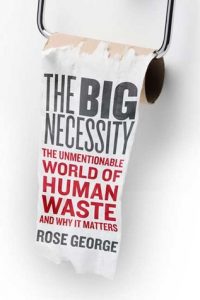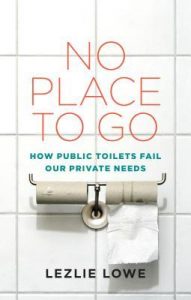As for public toilets, they too often fail people, especially the vulnerable and marginalized, either because they don’t exist or because they don’t accommodate all that people might need or want to do in them (Wald, 174).
Any long-time VPL blog readers will find it no surprise that I immediately placed on hold and subsequently devoured* Pipe Dreams: The urgent global quest to transform the toilet within a couple days of receiving it. But if you haven’t (yet) had the pleasure(?) of reading my enthusiastic gushing about the alimentary canal and writing probably altogether too many times the word “intestine” in any one paragraph… just know that an entire book dedicated to toilets is to me essentially a siren call (not toilet humour, mind you – though Pipe Dreams is fun to read and at times funny, and the book is not completely without puns – but Wald focuses much more on topics such as the social consequences of water flushing toilets and the sewers they require, the lack of toilets in many parts of the world – including within the U.S.! – as well as serious considerations on the topic of what to do with all that urine and fecal matter, because we’re not about to stop production anytime soon!).
So if you’ve never thought too much about toilets until you found yourself out about town**, on a hike, or maybe on a roadtrip, desperately trying to recall where the last public toilet (or more likely, gas station) was, or conjecturing whether one will come up soon, join us as we embark upon this journey into toilets, the sewers, and so many different ways to manage fecal sludge and urine that you never knew you wanted to learn about, all on the quest for Loo-topia!
*Would you like me to stop using words we generally associate with eating to discuss a book about toilets & fecal matter treatment? No such luck.
**Also, can anyone please enlighten me why bodysuits are experiencing a moment? You need to disrobe almost entirely before being able to safely use the washroom without the risk of soiling your clothes, right? I see bodysuit sellers styling their wares with jeans or skirts as if to go out, but every time I see this, no matter how well put together the outfit, I can’t help but wonder: How do you pee? Even worse if it’s layered with a cardigan or something: what if the public washroom doesn’t have hooks on the inside?? Where are you going to put your layers so they remain unsoiled (by you or the ground of the public washroom) so you can put them back on without feeling grossed out?!?? Please, someone, let me in on the secret.
 “Excited about fecal sludge?!”, you might be thinking. Yes. Do you know how many pounds of fecal matter & how much urine a person produces per year, on average? “[A]ccording to a synthesis of findings from around the world, about 100 pounds of poop and about 140 gallons of pee per person each year” (Wald, ix). I know many/most of us tend to – or perhaps would prefer to – flush and forget unless the toilet is malfunctioning, we’re in the throes of gastrointestinal distress*, or after natural disasters (or an especially rough downpour) when sewers might overflow, causing beaches to close, and make it impossible to not think about where everything goes when it gets flushed, but without really thinking about our pee and poop, how can we even begin to consider other possibilities when it comes to dealing with our sewage waste outside of our existing infrastructure?
“Excited about fecal sludge?!”, you might be thinking. Yes. Do you know how many pounds of fecal matter & how much urine a person produces per year, on average? “[A]ccording to a synthesis of findings from around the world, about 100 pounds of poop and about 140 gallons of pee per person each year” (Wald, ix). I know many/most of us tend to – or perhaps would prefer to – flush and forget unless the toilet is malfunctioning, we’re in the throes of gastrointestinal distress*, or after natural disasters (or an especially rough downpour) when sewers might overflow, causing beaches to close, and make it impossible to not think about where everything goes when it gets flushed, but without really thinking about our pee and poop, how can we even begin to consider other possibilities when it comes to dealing with our sewage waste outside of our existing infrastructure?
For example, we hear all about water conservation and how taking shorter showers can help the environment, but even this piece of well meaning advice is not as applicable globally as it seems at first glance: even water conservation can be taken too far, as the city of Cologne has experienced in Germany. Because their sewer system’s pipes were built for a much higher volume of water, when not enough water goes through these pipes, what’s in the sewers doesn’t get flushed out, causing buildup. I say this not to discourage water conservation efforts, because obviously this depends on many factors, like rainfall in the region and how large the pipes are, and how much water is used in the area, but to bring to mind the consideration that maybe there’s no actual one-size-fits-all solution to the toilet problem that can be implemented worldwide. And this is something Wald talks about throughout Pipe Dreams as well: that the indiscriminate implementation of water flushing toilets regardless of the locale in which these toilets & sewers have been installed is part of the problem: toilets and waste management have to be culturally appropriate.
*Or perhaps all the more so when experiencing gastrointestinal distress, we’d like to forget it ever happened? I’d assume we’d want to remember what happened leading up to that moment on the throne, but this probably differs from person to person.
 How about the idea of really getting ankle deep into poop to turn all that human waste into fertilizer, or energy? Some of my favourite parts of Pipe Dreams were reading about all the different ways that human waste – urine & poop specifically, though lots of other fun things that shouldn’t get thrown down the toilet bowl do get thrown in anyway: please don’t flush tampons or menstrual pads, or condoms, and reconsider flushing that “flushable wipe” – can be harnessed to produce fertilizer and energy that fuel other endeavours, such as agriculture, or produce power from the heat lost in the sewers. The hardest barrier to overcome might just be the ick factor, because if you consider that people are coming up with ways to upcycle sewer water & fecal sludge into clean drinking water & fertilizer for crops that go on to feed people, I don’t know how else to describe these efforts & ideas as but REALLY COOL. Yes, poop can be dangerous as a vector of disease, but poop can also be an incredible resource! And what’s more, supply will never end (until all of humanity dies off or evolves to no longer excrete waste) because we all pee and poo! So imagine that we can funnel all that waste we contribute to and turn it into something useful that helps address other issues (e.g. diminishing fertilizer supply; liquid fertilizer runoff after precipitation, since fertilizer made of fecal sludge would require interaction with plants to release the nutrients for uptake). It’s not that using human excrement will solve these other issues, but it’d be great if we could kill one bird (the issue of what to do with fecal sludge, urine, etc.), and harm another bird even if we can’t kill it (fertilizer, energy, etc.), with one stone. (It is my sincerest hope that no actual birds will be harmed in the process.)
How about the idea of really getting ankle deep into poop to turn all that human waste into fertilizer, or energy? Some of my favourite parts of Pipe Dreams were reading about all the different ways that human waste – urine & poop specifically, though lots of other fun things that shouldn’t get thrown down the toilet bowl do get thrown in anyway: please don’t flush tampons or menstrual pads, or condoms, and reconsider flushing that “flushable wipe” – can be harnessed to produce fertilizer and energy that fuel other endeavours, such as agriculture, or produce power from the heat lost in the sewers. The hardest barrier to overcome might just be the ick factor, because if you consider that people are coming up with ways to upcycle sewer water & fecal sludge into clean drinking water & fertilizer for crops that go on to feed people, I don’t know how else to describe these efforts & ideas as but REALLY COOL. Yes, poop can be dangerous as a vector of disease, but poop can also be an incredible resource! And what’s more, supply will never end (until all of humanity dies off or evolves to no longer excrete waste) because we all pee and poo! So imagine that we can funnel all that waste we contribute to and turn it into something useful that helps address other issues (e.g. diminishing fertilizer supply; liquid fertilizer runoff after precipitation, since fertilizer made of fecal sludge would require interaction with plants to release the nutrients for uptake). It’s not that using human excrement will solve these other issues, but it’d be great if we could kill one bird (the issue of what to do with fecal sludge, urine, etc.), and harm another bird even if we can’t kill it (fertilizer, energy, etc.), with one stone. (It is my sincerest hope that no actual birds will be harmed in the process.)
 If you don’t find yourself getting that excited when thinking about fecal sludge as a potential source of fertilizer or energy, how about the social consequences of decisions made about toilets? Have you thought about why public washrooms are single-gender to begin with, instead of being universal, and why there are always long lines for the women’s washrooms? Both of these phenomena find their roots in (surprise surprise) Victorian times. As Wald notes, our private (home) washrooms are universal (in that it’s not dictated by gender), and universal public washrooms in other countries isn’t something novel. Personally, the first time I used a universal washroom in Europe and walked out of the stall as someone was using the urinal, it really wasn’t that awkward. And then when I encountered the giant universal washroom in Yorkdale Mall, I don’t know how to say this without sounding like a toilet fanatic but that is what I always return to when I think of the best public* washroom I’ve encountered thus far** in North America.
If you don’t find yourself getting that excited when thinking about fecal sludge as a potential source of fertilizer or energy, how about the social consequences of decisions made about toilets? Have you thought about why public washrooms are single-gender to begin with, instead of being universal, and why there are always long lines for the women’s washrooms? Both of these phenomena find their roots in (surprise surprise) Victorian times. As Wald notes, our private (home) washrooms are universal (in that it’s not dictated by gender), and universal public washrooms in other countries isn’t something novel. Personally, the first time I used a universal washroom in Europe and walked out of the stall as someone was using the urinal, it really wasn’t that awkward. And then when I encountered the giant universal washroom in Yorkdale Mall, I don’t know how to say this without sounding like a toilet fanatic but that is what I always return to when I think of the best public* washroom I’ve encountered thus far** in North America.
*I realize a mall washroom isn’t actually public per se… but I also cannot call to mind a single actual public washroom that wasn’t a porta potty, so I’m working with what we’ve got.
**Is this something I think about frequently, you might be wondering? No, but I have thought back to my experience of that washroom more than once and the memory is still a positive one. Also, I haven’t made it a point to visit many public washrooms throughout North America, so I definitely have a small sample size. Comment below about your favourite public washroom!
And on that note, I’ll leave you with some crappy food for thought:
In one sense, toilets are the great equalizer… But they’re also a metric for inequality in any society and in any era. Show me the toilets you use and I can tell you a lot about your status… The people at the bottom, meanwhile, know that toilets can serve as a tool of control, punishment, or exclusion – one with potentially life-threatening consequences. (Wald, p.173)
So when free, accessible public washrooms – by which I don’t mean the washrooms at your local café but truly public washrooms – are not widely available, what does this tell us about how we as a society consider those experiencing homelessness, about pregnant women, about children and mothers, about people who menstruate (I doubt I’m the only one who has had to struggle to change a menstrual product in a washroom outside of a home), and many more besides?
Other titles you might enjoy:
Gut by Giulia Enders, which I wrote about before.
Feminist City by Leslie Kern
The Origin of Feces by David Waltner-Toews
